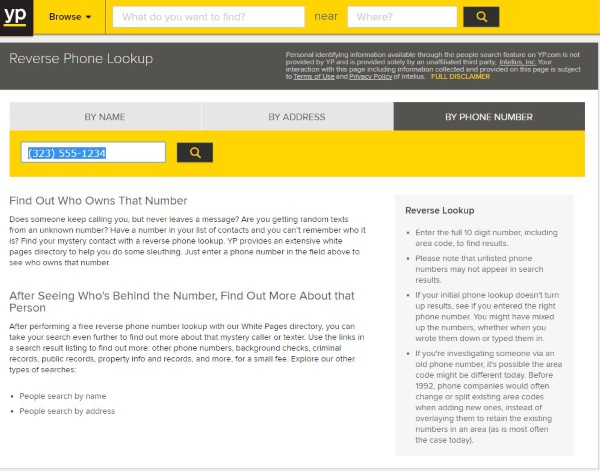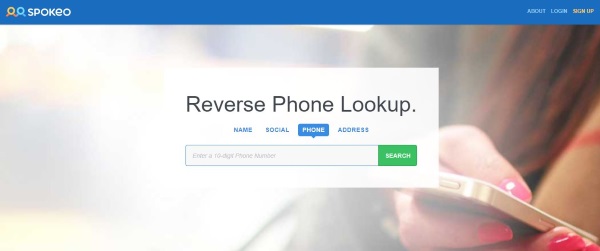How To Find Who Called Through a Reverse Phone Lookup

If you get a lot of marketing calls or just want to know who called you, reverse phone lookup can help. You provide the phone number of who called into a website or directory page and it can often identify who called you and whether it is a legitimate company or telemarketer.
Reverse phone lookups mainly work on landline numbers but can work on cell numbers too. This would be more useful if you’re wondering if a buddy got a new phone or whether it’s that cute guy or girl you met in the mall who you gave your number to. Cell numbers aren’t part of public record as much as landlines, so finding and correctly identifying them can be a little more difficult than on a landline.
How reverse phone lookup works
As you can imagine, a reverse phone lookup looks up the name and/or address of a caller by providing their number. It is reverse because previously, we would look up someone’s number from their name and/or address. Where we used to perform these searches using phone books it has moved online.
To understand how a reverse phone lookup works, first it is useful to know how a landline number is made up. A typical phone number is 10 digits long and comprised of what is called the ‘3-3-4 scheme’.
- The first three digits are the area code and are regulated by the FCC.
- The second three digits are the carrier prefix. This used to be the nearest telephone switch to where the line was located but thanks to number portability (the ability to take your number with you) and digitization of networks, this is no longer true.
- The final four digits is the number of the actual line connecting the property.
So when identifying a phone number, the first three digits narrows down the city, the second three the neighborhood or area and the final four, the line itself.
For example, take the number 323-555-1234. Using the information above, we know that 323 is the city, in this case, Los Angeles. The 555 is the carrier prefix, in this case, the fictional prefix used in all TV shows and movies. The 1234 part is the actual line identifier of the person or business.
Back in the days of phone directories, you would look up a name or address to identify their number. You could also call 411, Directory Assistance for help. Directory Assistance would look up the name or address using phone directories provided by the various phone companies to give you the information.
Those directories have now been digitized and are able to be referenced by web applications. This is how you can perform a reverse phone lookup. Rather than you calling Directory Assistance and asking the bot, you enter the phone number into a website and as the website to query a different bot with access to the same information.
As long as the phone number has not been made private, it should be available online. Some websites also take information from users to offer a reputation score depending on feedback.
Some of the websites listed below also show similar numbers as well as exact matches. This is because some businesses will buy a range of numbers and will make outbound calls using some of them rather than one. For example, a business may buy the range 323-555-1234 to 323-555-9876. They may make outbound calls from a few of those numbers and not others. By returning similar numbers, you could potentially identify whether the caller was part of a number range or not.
Perform a reverse phone lookup
So now you know how a phone number is made up and where the different services get their information from, let us look at how you perform a reverse phone lookup.

We can use the world’s largest search engine to perform a search for us and it can often return some useful information. You have two main options, you can put in the phone number and perform a search and see what comes up. You can also search for ‘reverse phone lookup’, find a specific website and do it that way.
The first method, adding the number that called into search is probably the easiest. You can either type it in as a single string, or separate using hyphens. I find the second method works best as Google correctly identifies it better as a phone number. You will likely see a selection of websites purporting to have the information you need.
Some of these websites will indeed have the information you need. Some will not and seem to serve no purpose other than to waste your time.
Here are some websites that don’t waste your time.

WhitePages.com
WhitePages.com is probably the largest data provider on the internet. Certainly for US data anyway. One of the free services it provides is a reverse phone lookup. Navigate to the page, select Reverse Phone Lookup from the center, paste the number and hit Search.
WhitePages apparently covers 85% of the US population and millions of phone numbers so chances are good that it can identify who called you. Search takes a little while and should return a page showing the Spam or Fraud potential of the number, how many people searched for it and whether it is a landline or mobile number.
Select More Facts and you may be presented with a Google Map showing the general area of the carrier prefix and a list of anyone with the same or very similar number. It is quite a comprehensive return considering it is free.

Zabasearch
Zabasearch is another huge repository of data worth considering. It includes its own white pages, lots of search criteria and quite a comprehensive reverse phone lookup feature. Add the phone number to the search box in the center and select Search.
The search may take a little while but should return a page that shows where the number is located and anyone with the same or similar numbers. The basic search is free and should identify any caller who is in the public phone directory. If the number is unlisted or fake, Zabasearch will tell you.
More advanced searches are possible but they cost money. I haven’t tried a paid search using Zabasearch so cannot comment on whether it is worth the investment or not.

YP.com
YP.com is part of AT&Ts Yellow Pages brand, which is instantly recognizable once you land on the website. The site offers a basic reverse phone lookup service for free and a more advanced on for a price. The basic search works well. Enter the number in the search box and hit search. If the site finds details on the number, it will provide them on the page.
Like the other sites in this list, search can take a while depending on how busy the site is. Once complete, you can see all pertinent data relating to that number. Unlike other sites in this list, YP.com does not provide similar numbers, only an exact match.

Spokeo
Spokeo is a neat little site that works very quickly to find your number. This is a bait site that provides the very basic information on a number but will charge you to access the data. If you are determined to find out who called you, Spokeo is also apparently one of the most accurate sites out there which is why it is featured here.
Type your number into the center and select search. The site will quickly generate a return of the same or similar numbers for you to browse. Select the right number, select View Details and pay $1.95 on the next page. You then get to see the owner’s name, address, location, family members, address history, carrier and all sorts of information.
While you do have to pay for the information, the quality and quantity of the data surpasses any of the free offering here. Worth it if you really must find who called.

SpyDialer.com
SpyDialer.com has a curious name but a powerful search function. Of all of the websites I tried, only Spokeo worked faster. The website is very basic but gets the job done. Enter the number in the center and hit Search. After a couple of seconds you are taken to the results page where the name, address and any comments from previous searchers are listed.
This site can also tell you whether the number is a cell or landline. Not something made obvious in any of the other websites here. While not as comprehensive as Spokeo, searches are free and you can perform as many as you like. You can further cross reference names, addresses and emails within the site.
There are dozens of reasons why you might want to perform a reverse phone lookup. Now you now how the system works and how to find out who called. What you do with that information is up to you!
Do you know of any other reliable reverse phone lookup resources? Got any stories or anecdotes about using these services? Tell us about them below if you do!
















